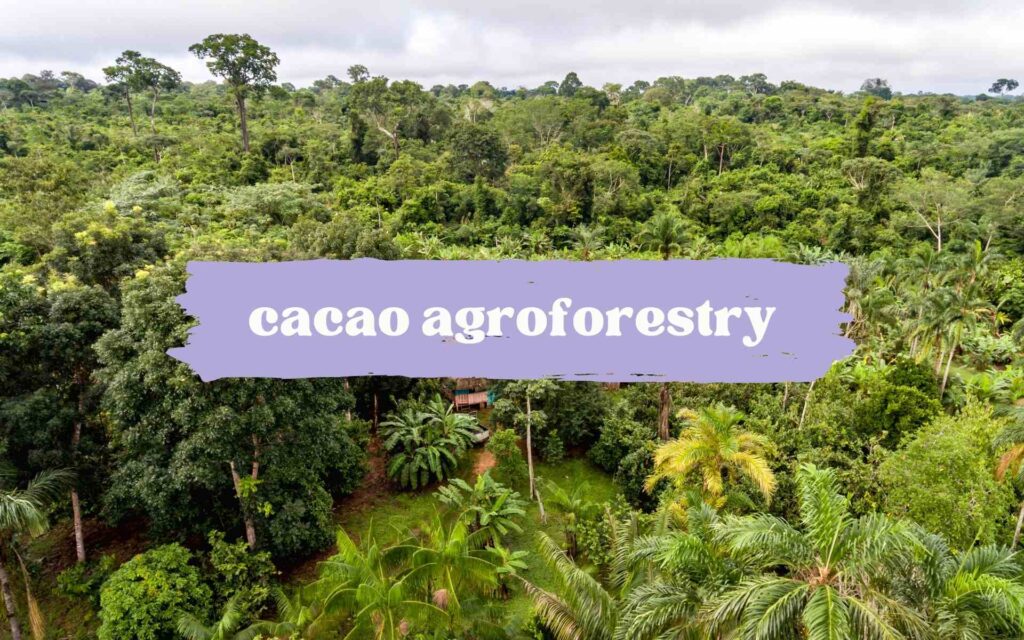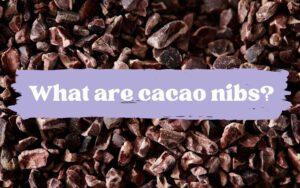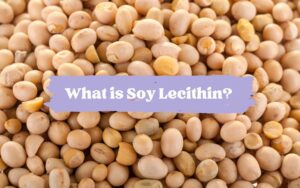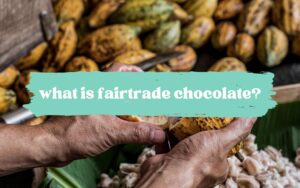Chocolate is booming. The world’s desire for chocolate is forecasted to grow by nearly USD 20 billion over the next five years. To meet this rising global demand for chocolate, pristine forests and grasslands are being cleared to make way for monoculture cacao farms.
Cacao farming is one of the leading causes of deforestation in many parts of West Africa and South America. In 2017, The Guardian reported that 80% of rainforest cover in the Ivory Coast has disappeared, largely due to cacao farming.
However, chocolate doesn’t have to come with a bittersweet aftertaste at the cost of the planet and farmers. There are alternatives – alternatives that many farmers and chocolate makers have been advocating for years. In this post, we take a closer look at one of these alternatives – cacao agroforestry.
The issue with cacao monocultures
Cacao monoculture is the cultivation of only cacao trees on a piece of land. In the short term, monocultures have been found to produce up to 40% higher yields, however, this unsustainable farming method quickly causes the soil to degrade, loose its nutrients and dry up. Thus, to maximise the short-term profitability, more forests are cleared to make way for more monoculture cacao.
This slash-and-burn technique is a major cause of deforestation, soil erosion and biodiversity loss which makes the cacao trees vulnerable to the impacts of climate change as well as pests and diseases. Therefore, as well as an environmental catastrophe, this style of farming is hugely unsustainable over the long-term for small-holder farmers.
We spoke to Petra Kollmannsberger, the CSO at 12-Tree, an organisation dedicated to sustainable forestry and agricultural projects. Petra told us that, “we need to understand that hundreds of millions of poor farmers are trying to support their families on a small area of land without access to fertilizers and other technologies.”
She continued, explaining that in developing countries, deforestation for agriculture is closely linked to land degradation and social deprivation cycle. Petra explained that this cycle goes something like this: “a desire for security and wealth drives deforestation and unsustainable use of soils and water, all of which cause land degradation. In farmers’ fields, this is seen in soil erosion, breakdown of nutrient cycling, and the loss of soil fertility and structure. All of these things result in lower crop yields.
Low cocoa prices accelerate the speed of the downward progress. The low productivity combined with low cocoa prices results in low income and prevent farmers to purchase the inputs essential for agricultural production. They are, thus, forced to clear the forest to open up new fields and so return to the cycle.”
So how do farmers escape this cycle? One solution is agroforestry.
What is cacao agroforestry?
The UN Food and Agriculture Organisation (FAO) define agroforestry as: “A dynamic, ecologically based, natural resource management system that, through the integration of trees on farms and in the agricultural landscape, diversifies and sustains production for increased social, economic and environmental benefits for land users at all levels.”
So, cacao agroforestry is the cultivation of cacao trees, amongst other plants and crops, as opposed to the production of only cacao trees in a monoculture plantation.
Petra tells us that, “agroforestry can interrupt this deforestation cycle [mentioned above]. Leguminous trees and shrubs in cropping systems initiate the process of agroecological restoration, rebuilding soil fertility while boosting agroecosystem functions that reduce the risk of pests, diseases, and weed outbreaks; all of which result in higher [long-term] productivity.”
“Agroforestry is not only ensuring the sustainability of environmental aspects, but also making sure it meets the needs of social and environmental aspects of local communities.”
Petra Kollmannsberger (CSO at 12Tree)
Agroforestry has been gaining popularity in the US and in Europe in the agricultural sectors. Its practice goes back hundreds of years in many parts of Central and South America. It’s now making a comeback in cacao farming as farmers recognise they must protect their land in order to mitigate the risks of climate change.
According to recent reports, cacao could disappear within the next 40 years, due to the unsustainable practices of monocultures. As a response, in countries such as Ghana and Côte d’Ivoire, where the majority of the world’s cacao is grown in monoculture systems for decades, agroforestry is slowly being introduced as farmers are encouraged to grow mangoes, cashews and other trees and crops alongside their cacao.
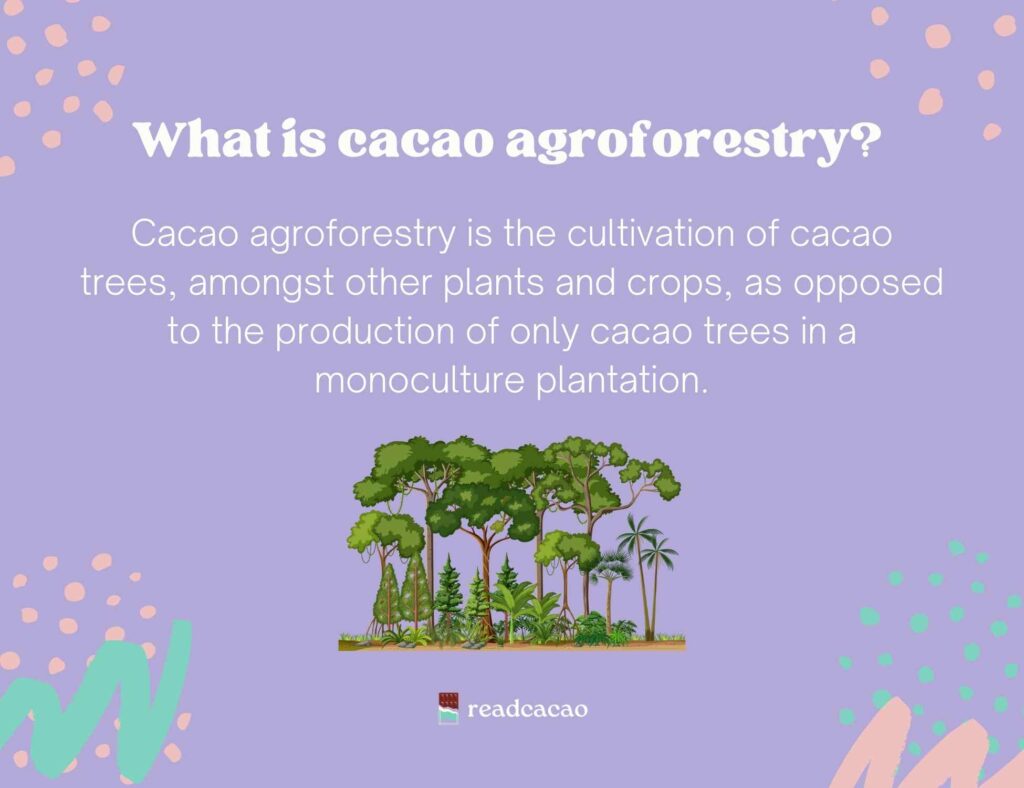
What are the benefits of cacao agroforestry?
So what are the benefits of cacao agroforestry?
As Petra explained, “with intensive farming and forestry, humans have grown accustomed to putting economic interests before those of nature. The planet is suffering as a result. Local populations are suffering. Biodiversity is in decline. Sustainable agroforestry takes the opposite approach, putting people’s interests and sustainable farming first.”
Protects biodiversity & helps local communities
The research on agroforestry and its benefits on biodiversity are plentiful. Not only does agroforestry reduce the rate of conversion of natural habitats into agricultural land. However, it has also proven to provide a habitat for species on dedicated farmland. Moreover, it provides a connected landscape for species, as opposed to fragmented ecosystems.
Lastly, agroforestry mimic natural forests. Because of this, they provide ecosystem services such as protection against soil erosion, water conservation, and natural pest and disease management. Thanks to this, it prevents degradation of the habitat and instead allowing biodiversity of flora and fauna to flourish.
However, as Petra elaborates, “agroforestry systems don’t only contribute to environmental conservation, but can also increase the chances of a successful cocoa farm both from an agronomic and economic point of view.”
She continues: “Agroforestry is not only ensuring the sustainability of environmental aspects, but also making sure it meets the needs of social and environmental aspects of local communities. An agroforestry project must not only revitalize a plot of land or forest, but also improve local employment, health-care, education and social welfare for its communities, and build bridges between communities of investors, farmers and international buyers that have much to offer one another.”
Improve livelihoods of small-holder farmers
As Petra mentioned above, of course ensuring environmental conversation is crucial. However, it must also meet the economic needs for small-holder farmers to make a living. Agroforestry not only ensures long-term land-use sustainability and thus protects future income. However, it also allows farmers to diversify their income streams.
“With shade trees, the same plot of land can be used to produce two or more crops that are linked to different markets, increasing the economic resilience of a farm,” says Petra. “For example, many cocoa farmers use bananas and plantains as shade crops, as they are typically consumed in cocoa-producing countries. This local market for the shade crops brings an earlier profit return to the farm.”
As well as growing trees for shade, other crops such as beans can provide other benefits such as fixing nitrogen in the soil. “Using plants from the bean and pea family, such as pigeon peas or madre cacao, as primary shade can also be planted on the farm, as they help fix nitrogen in the soil,” explains Petra. “Shade decreases the number of weeds in the farm, lowering the costs of weeding in the operation and ensuring fertilization is more effective. In 12Tree we use different shade crops depending on the local market opportunities and soil specification. This can range from coconut palms to native tree species for timber production, rubber trees, cardamom, papaya, plantain and peas.”
Not only does agroforestry and the diversification of crops improve the earning potential throughout the year. However, it can also reduce the cost of inputs such as fertiliser and water usage. “A [monoculture] cocoa plantation, for example, will require a higher water lamina than an agroforestry plantation, because of the reduction in evapotranspiration. Lower water requirements mean smaller investment in pumps, wells and reservoirs, and less energy consumption because of shorter irrigation turns. In other words, lower operation costs.”
Mitigates the risk of climate change for farmers
Another benefit of a diversified farming system such as agroforestry is that they are able to, “adapt and resist the effects of droughts, floods, hurricanes and extreme climatic events given that complex agroecosystems and diversified plots have more topsoil, greater soil moisture and less erosion.”
In comparison to monoculture farming, agroforestry systems have shown a higher resilience to natural disasters. “Field observations reveal that resilience to climate disasters is closely linked to the level of on-farm biodiversity, a major feature of agroforestry systems. After Hurricane Mitch and Hurricane Stan, farms in Mexico and Central American hillsides exhibiting high levels of vegetational complexity and plant diversity suffered less damage than their conventional monoculture neighbours.”
Key takeaways
Monoculture cacao plantations are a leading cause of deforestation rates around the world. These outdated farming systems require high amounts of external inputs such as water and fertiliser. Not only are they having devastating effects on landscapes in cacao growing regions. However, they also threaten the long-term livelihood of small-holder farmers around the world.
Agroforestry is an ancient farming technique that is, fortunately, making a come back. This farming technique has demonstrated that it can benefit the environment as well as provide multiple economic and social benefits. Many environmentally-conscious chocolate makers already source their beans from farms or cooperatives that utilise cacao forests. Monoculture cacao is a result of chocolate brands who prioritise short-term profit over long-term sustainability.
We as consumers hold a large amount of power in our hands in shaping the future we imagine. Let’s choose a better world with our wallets. Let’s support the chocolate makers who have been advocating agroforestry projects for a long time.
A huge thank you to Petra Kollmannsberger at 12 Tree for the incredibly insightful overview of agroforestry and its many benefits!

